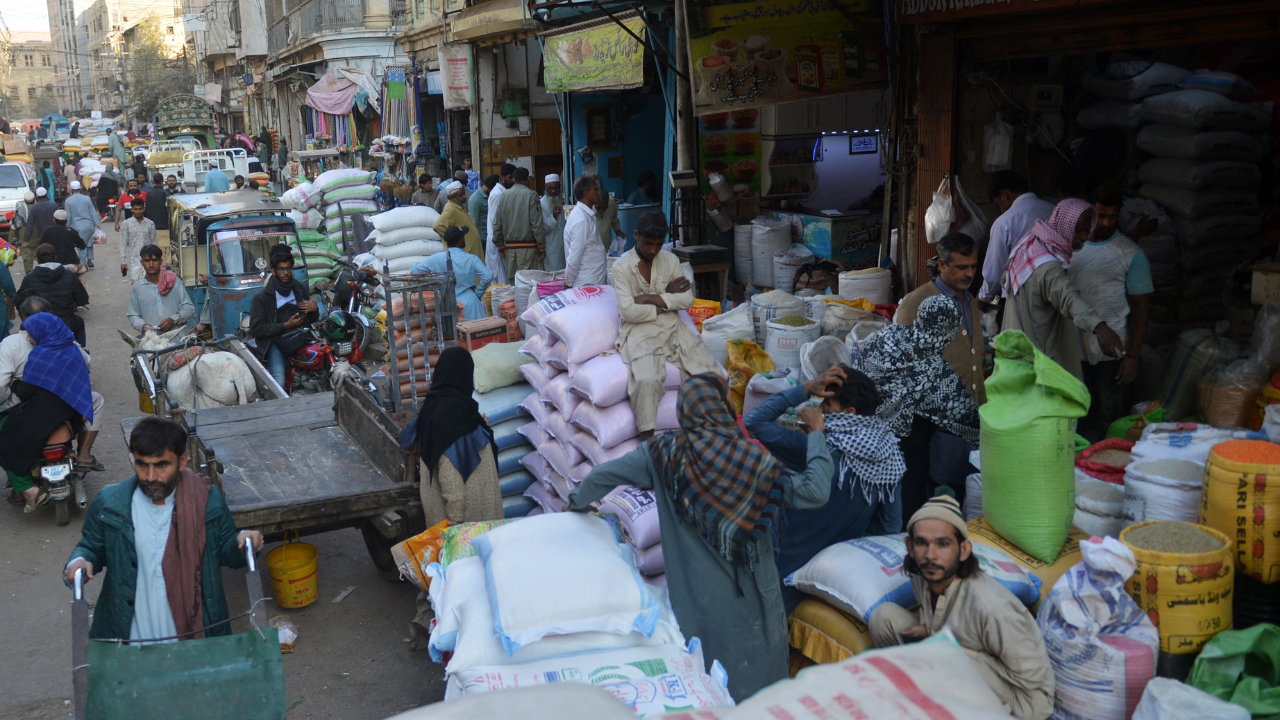For months, the world’s fifth-most populous country has been inching closer to debt default, echoing the cautionary tales of other developing economies, including Sri Lanka and Venezuela. Inflation is at a 48-year high. Foreign exchange reserves cover less than a month of imports. The bill for billions in damages from last year’s devastating floods continues to hurt, highlighting the financial consequences of a warming planet.
Pakistan’s cotton production nearly halved due to extreme floodingA worker wades through flooded water at New Jhoolay Lal Cotton Ginners & Oil Mill in Sanghar district, Sindh province, Pakistan on Friday, September 9, 2022. About 45 percent of production from Pakistan, the world’s fifth largest cotton producer, was destroyed by extreme flooding, forcing the country to spend $3 billion to import the raw material for its textile industry.
Talks over bailout money from the International Monetary Fund failed to deliver a deal this week and will continue, without providing an immediate respite. However, the amount on the table – part of a $6.5 billion loan program – is still far from enough to replenish Pakistan’s depleted coffers.
Fighting between the government of Prime Minister Shehbaz Sharif and Imran Khan, the ousted former leader, has split the country. National elections scheduled for the second half of 2023 could become chaotic. And a recent suicide bombing in the city of Peshawar killed more than 100 people, illustrating the risks of Islamabad’s continued ties with the Taliban, which has tightened their grip on neighboring Afghanistan.
To understand the crisis, Bloomberg News spoke to Pakistanis across the country. Here are their stories:
Muhammad Rashid, restaurateur
In Karachi, a bustling port city, rising inflation has hit local businesses. Muhammad Rashid, the owner of Rashid seafoodsaid his restaurant’s sales were down 50% this winter.
Middle-class shoppers, in particular, are staying away, bringing into focus growing inequality as the prices of staples like bread and meat soar.
“Now, our customer base is mostly from the business class,” said Rashid. “The rich have no problems and keep coming here to eat fish”.
Irfan Ali, manager of the gas station
Diesel is another pain point in Pakistan. The government raised prices to more than Rs 262 a liter last month, prompting many to cut back on commuting.
The lanes are emptier at Total Parco Pakistan Ltd., a gas station in a busy part of Karachi. Irfan Ali, the manager, said he was selling 15,000 liters a day when petrol cost 200 rupees a litre. Now, with fuel at almost 250 rupees a litre, that number has dropped to 13,000. He said competition for business is fierce.
“We’re running from our margins, so we’re not laying off any of our staff,” Ali said. “Inflation will definitely increase unemployment.”
Farzana, housekeeper
Many ordinary Pakistanis are taking out loans to afford basic necessities.
Farzana, who works as a maid in one of Karachi’s posh neighborhoods, said she was forced to borrow Rs 5,000 a month to keep up with the rising cost of living.
His electricity and gas bills have doubled, and recent gallbladder surgery has reduced the family’s savings. To meet the monthly expenses, Farzana’s 16-year-old son took a job in a restaurant and stopped attending school.
“Life has become very hard, but what can you do?” said Farzana. “I even sold all my jewelry to handle our household expenses.”
Mohammad Rashid, farmer
In rural parts of the country, farmers have suffered particularly heavy losses, as high fuel and electricity costs have reduced their profits.
Mohammad Rashid, who grows wheat, sugarcane, pulses and livestock fodder on a small 20-acre farm in Punjab’s Khushab district, said labor costs had risen dramatically in the past two years.
Last summer, floods killed more than 1,300 people in another part of Pakistan, causing more than $30 billion in damages.
Officials have pushed wealthier nations to foot the bill. Pakistan is ranked as the eighth most vulnerable country in the world to climate change, yet contributes only 1% of global emissions.
“We don’t have enough to spend on food,” Rashid said. “So how do we manage things like clothes, education, electricity?”

